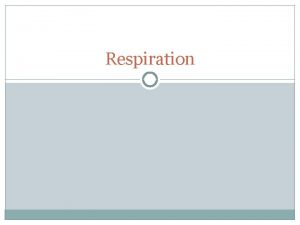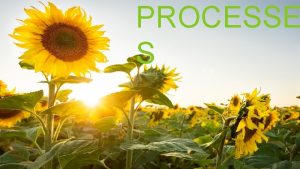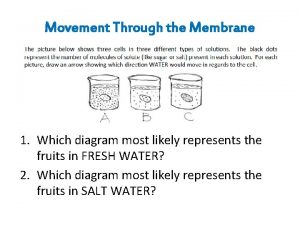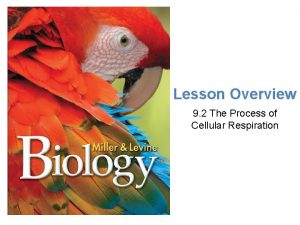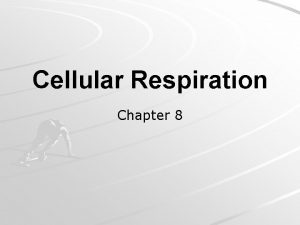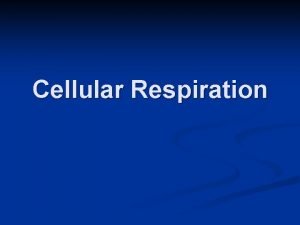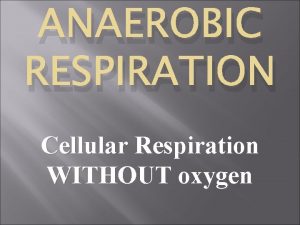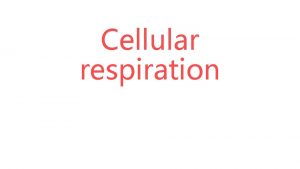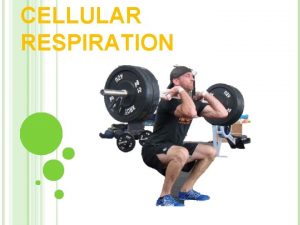Cellular Respiration Unit 4 Energize Your Life Chapter















- Slides: 15

Cellular Respiration Unit 4: Energize Your Life Chapter 9

Remember: How Do We Get Energy From ATP? By breaking the highenergy bonds between the last two phosphates in ATP Copyright Cmassengale

Chemical Energy from Food Cells have to convert food into chemical energy. Cellular respiration is the process that releases energy by breaking down food molecules in the presence of oxygen. This occurs in the mitochondria.

Overall Equation for Cellular Respiration C 6 H 12 O 6 + 6 O 2 YIELDS 6 CO 2 + 6 H 20 + 36 ATP’s Copyright Cmassengale

Cellular Respiration There are 3 stages of cellular respiration: –Glycolysis –The Krebs Cycle –Electron Transport Chain

Cellular Respiration Overview Mitochondrion Electrons carried in NADH Glucose Glycolysis Cytoplasm Pyruvic acid KREBS Electrons carried in NADH and FADH 2 ETC Mitochondrion

Where Does Cellular Respiration Take Place? It actually takes place in two parts of the cell: Glycolysis occurs in the Cytoplasm Krebs Cycle & ETC Take place in the Mitochondria. Copyright Cmassengale

Glycolysis 1 molecule of glucose (C 6 H 12 O 6) is broken in half into 2 molecules of pyruvic acid. Glycolysis does NOT require oxygen (anaerobic). Glycolysis occurs in the cytoplasm. NAD+ is an electron carrier that helps make ATP. Glycolysis = net gain of 2 ATP

If Oxygen Is NOT Present… No O 2 after glycolysis = the cell goes into Fermentation releases energy from food in anaerobic conditions (No Oxygen). 2 Types: alcoholic fermentation lactic acid fermentation Fermentation gives you a net gain of 2 NAD+ and harmful byproducts.

If Oxygen Is Present… O 2 is present after glycolysis = Krebs Cycle Pyruvic acid (produced by glycolysis) is broken down into CO 2 Krebs Cycle occurs in the mitochondria

Products of the Krebs Cycle From 2 molecules of pyruvic acid – 6 molecules of CO 2 – 8 NADH (electron carrier) – 2 FADH 2 (electron carrier) – 2 molecules ATP

Electron Transport Chain Electrons are passed from NADH and FADH 2 (produced in Krebs) through the electron transport chain. ETC uses these electrons to convert 32 ADP into 32 ATP. This must happen in the presence of oxygen (aerobic). This also produces 6 water molecules.

Electron Transport Chain Animation Copyright Cmassengale

Diagram of the Process Occurs across Cristae Occurs in Cytoplasm Occurs in Matrix Copyright Cmassengale

End Results The complete breakdown of glucose through cellular respiration (including glycolysis) results in the production of 36 ATP molecules. Glycolysis = 2 ATP (net gain) Krebs Cycle = 2 ATP Electron Transport Chain = 32 ATP
 Chapter 8 section 3 cellular respiration
Chapter 8 section 3 cellular respiration Chapter 9 cellular respiration harvesting chemical energy
Chapter 9 cellular respiration harvesting chemical energy Explain how amp stimulates cellular respiration
Explain how amp stimulates cellular respiration Chapter 9: cellular respiration: harvesting chemical energy
Chapter 9: cellular respiration: harvesting chemical energy Cellular respiration redox
Cellular respiration redox The gray-brown haze often found over large cities is called
The gray-brown haze often found over large cities is called Chemiosmosis steps
Chemiosmosis steps Types of respiration
Types of respiration Lactic acid fermentation steps
Lactic acid fermentation steps Why is cellular respiration important
Why is cellular respiration important Complementary processes
Complementary processes Cellular respiration chemical equation
Cellular respiration chemical equation Cellular respiration reactants
Cellular respiration reactants Formula photosynthesis
Formula photosynthesis Starting materials for cellular respiration
Starting materials for cellular respiration Electron carriers in cellular respiration
Electron carriers in cellular respiration







